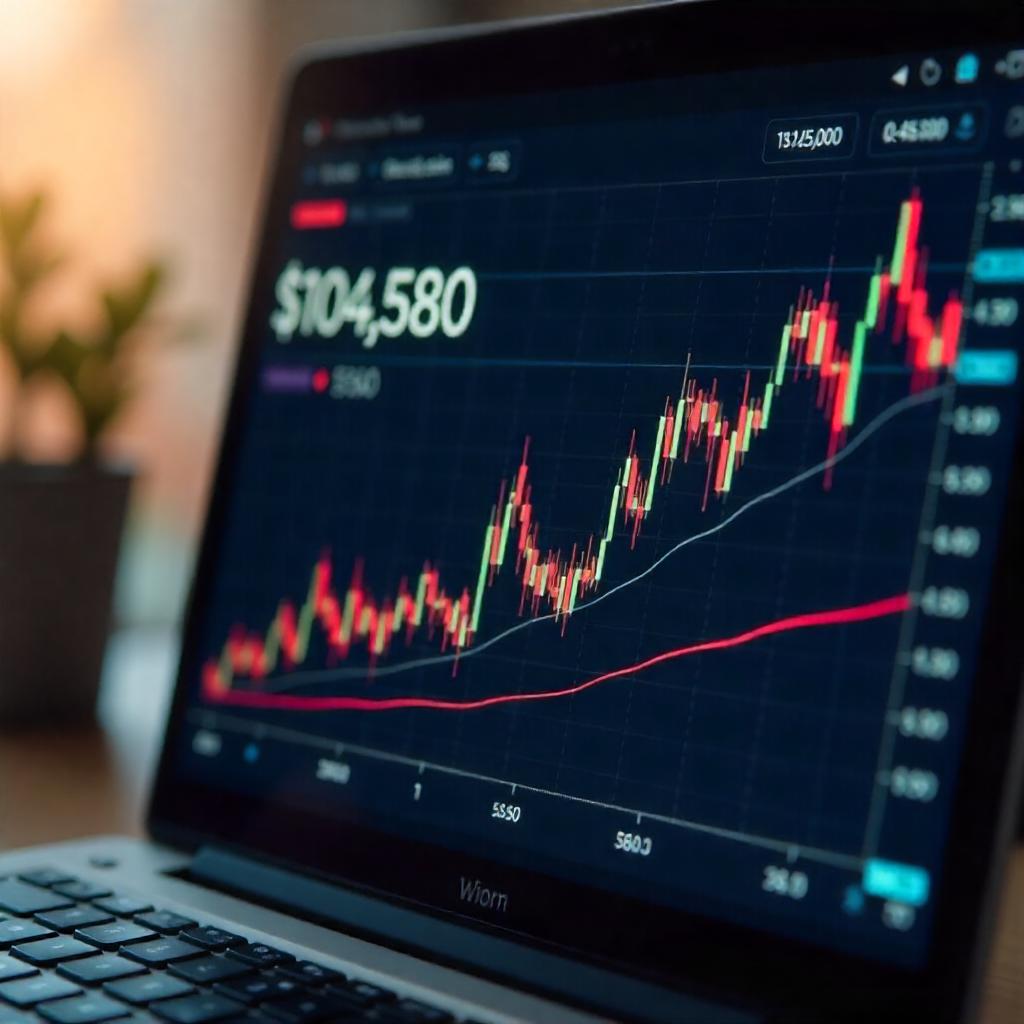Bitcoin’s recent dip to $104,000 has stirred a mix of concern and curiosity among traders and investors. While some view this as a temporary setback, others see it as a potential opportunity. Despite the price pullback, the Bitcoin options market is displaying signs of renewed optimism. This divergence between spot price movements and options market sentiment offers valuable insights into the current state of the cryptocurrency market.
In this article, we’ll delve into the dynamics of the Bitcoin options market, focusing on the 25 Delta Skew—a key indicator that reflects trader sentiment. By examining recent data and trends, we’ll explore why traders are positioning themselves for a potential upside, even as Bitcoin’s spot price experiences fluctuations.
Understanding these market signals is crucial for anyone involved in Bitcoin trading, whether you’re a seasoned investor or new to the space. By the end of this article, you’ll have a clearer picture of the factors influencing Bitcoin’s price movements and how to navigate the complexities of the options market. Let’s begin by exploring what the 25 Delta Skew is and why it matters.
Understanding the 25 Delta Skew in Bitcoin Options
The 25 Delta Skew is a pivotal metric in the Bitcoin options market, offering insights into trader sentiment and market expectations. Let’s delve into its significance and recent developments.
What Is the 25 Delta Skew?
The 25 Delta Skew measures the difference in implied volatility between out-of-the-money (OTM) put options and call options, each with a delta of 25%. Delta represents the sensitivity of an option’s price to changes in the underlying asset’s price. A positive skew indicates higher demand for calls, suggesting bullish sentiment, while a negative skew points to greater demand for puts, indicating bearish sentiment.
Recent Trends in the 25 Delta Skew
Over the past week, the 1-week 25 Delta Skew for Bitcoin options has flipped from -2.6% to +10.1%, and the 1-month skew has risen from -2.2% to +4.9%. This shift signifies a marked increase in demand for call options, reflecting a bullish outlook among traders.
These metrics indicate that, despite short-term volatility, the market sentiment is leaning toward an upward movement. The shift in the 25 Delta Skew is particularly important as it reveals how traders are positioning themselves for potential gains, signaling that the majority believe Bitcoin’s price may rise in the near future.
Current Market Sentiment
Despite Bitcoin’s recent dip to approximately $104,468, the options market is signaling a shift toward bullish sentiment. The 25 Delta Skew, a key indicator of market sentiment, has flipped to positive territory, suggesting that traders are positioning for potential upside.
The 1-week 25 Delta Skew has risen from -2.6% to +10.1%, and the 1-month skew has increased from -2.2% to +4.9%. This reversal indicates a growing demand for call options, reflecting optimism about Bitcoin’s near-term prospects.
Additionally, the Fear and Greed Index remains in the “Greed” zone, hovering around 68, indicating that investor sentiment is still positive despite minor fluctuations.
These developments suggest that, while Bitcoin’s price has experienced short-term volatility, the options market anticipates a potential rebound, with traders positioning themselves for upward movement in the coming weeks.
Factors Driving Bullish Sentiment in Bitcoin Options
Despite Bitcoin’s recent dip to approximately $104,451, several key factors are contributing to a resurgence of bullish sentiment in the options market. Traders are positioning themselves for potential upside, driven by a combination of institutional involvement, strategic hedging, and evolving market dynamics.
1. Institutional Accumulation and Strategic Positioning
Institutional investors are significantly increasing their Bitcoin holdings, with nearly 31% of the total supply now controlled by companies listed on Bitcoin Treasuries. This growing concentration of Bitcoin in institutional portfolios signals a shift towards mainstream adoption and reflects heightened confidence in Bitcoin as a strategic asset.
Notably, firms like MicroStrategy and BlackRock have been actively acquiring Bitcoin, further legitimizing its status as a store of value. BlackRock’s iShares Bitcoin Trust (IBIT) has amassed $57.5 billion in assets by February 2024, marking it as the world’s largest Bitcoin fund. These developments suggest that institutional players are not only holding Bitcoin but are also engaging in options trading to hedge and speculate on its price movements.
2. Strategic Hedging and Bullish Options Strategies
In the options market, traders are employing strategies such as the “bull put spread,” where high-strike put options are sold while purchasing others with more favorable, lower strike prices. This approach indicates a calculated bet on rising Bitcoin prices, even as some investors hedge against potential downside risks.
Additionally, the 25 Delta Skew metric has flipped to positive territory, suggesting increased demand for call options. This shift reflects a growing optimism among traders about Bitcoin’s near-term prospects.
3. Evolving Market Dynamics and Regulatory Developments
The launch of Bitcoin ETF options, starting with BlackRock’s iShares Bitcoin Trust (IBIT), marks a pivotal step in the mainstreaming of cryptocurrency. These products enhance market liquidity, reduce volatility, and attract institutional participation, positioning Bitcoin alongside traditional assets like gold.
Furthermore, the establishment of the U.S. Strategic Bitcoin Reserve in March 2025, which holds approximately 207,189 BTC, underscores the government’s commitment to integrating Bitcoin into the national financial infrastructure.
4. Geopolitical Tensions and Safe-Haven Demand
Rising geopolitical tensions, particularly in the Middle East, have prompted investors to seek assets perceived as safe havens. Bitcoin’s decentralized nature and limited supply make it an attractive option during times of uncertainty. This shift in investor behavior is reflected in the increased demand for Bitcoin options, as traders look to capitalize on potential price movements driven by global events.
5. Market Liquidity and Exchange Activity
Recent data indicates a significant increase in Bitcoin net exchange outflows, suggesting that institutional buyers are stepping back into the market. This activity supports prices at current levels and reflects growing confidence in Bitcoin’s value proposition. The rise in open interest and trading volumes in Bitcoin options further indicates that traders are actively engaging with the market, anticipating potential upside.
In summary, a confluence of institutional accumulation, strategic hedging, evolving market dynamics, geopolitical factors, and increased market liquidity is driving the bullish sentiment in the Bitcoin options market. These factors suggest that traders are positioning themselves for potential upside, even as Bitcoin’s price experiences fluctuations.
Implications for Short-Term Traders
The recent shift in Bitcoin’s options market sentiment presents both opportunities and challenges for short-term traders. Here’s how this evolving landscape impacts your trading strategies:
Enhanced Profit Potential
The positive 25 Delta Skew indicates increased demand for call options, suggesting that traders anticipate upward price movements. This environment can be lucrative for short-term traders employing strategies like:
- Scalping: Capitalizing on small price movements within minutes or hours.
- Day Trading: Opening and closing positions within the same trading day to benefit from intraday volatility.
- Swing Trading: Holding positions over several days to capture short-term trends.
These strategies can be effective when combined with technical analysis tools such as Moving Averages, Relative Strength Index (RSI), and Bollinger Bands to identify optimal entry and exit points.
Increased Volatility and Risk
While the bullish sentiment presents opportunities, it also brings heightened volatility. Short-term traders must be prepared for rapid price fluctuations. To manage this risk:
- Implement Strict Stop-Loss Orders: Set predetermined exit points to limit potential losses.
- Use Position Sizing Techniques: Avoid overexposure by adjusting the size of your trades relative to your portfolio.
- Monitor Market News: Stay informed about geopolitical events and economic data releases that can impact Bitcoin’s price.
For instance, despite Bitcoin’s recent price dip, it remained steady at $104,000, indicating resilience amid market fluctuations.
Psychological Factors
The current market sentiment can influence trader behavior. The fear of missing out (FOMO) can lead to impulsive decisions. To mitigate this:
- Stick to Your Trading Plan: Define your strategy and adhere to it, avoiding emotional reactions.
- Maintain a Long-Term Perspective: Recognize that short-term volatility is part of the market cycle.
- Avoid Herd Mentality: Make decisions based on analysis, not on the actions of others.
Understanding and managing these psychological factors are crucial for maintaining discipline and making informed trading decisions.
Strategic Adjustments
Given the current market dynamics, short-term traders might consider:
- Adjusting Strike Prices: Opt for options with strike prices that align with anticipated price movements.
- Diversifying Strategies: Combine different options strategies, such as straddles or spreads, to balance risk and reward.
- Monitoring Open Interest: Keep an eye on changes in open interest to gauge market sentiment and potential price movements.
By staying adaptable and informed, traders can navigate the complexities of the current market environment effectively.
Case Studies and Real-World Examples
Despite Bitcoin’s recent dip to $104,451, the options market is signaling a shift toward bullish sentiment. The 25 Delta Skew has flipped to positive territory, suggesting that traders are positioning for potential upside. This reversal indicates a growing demand for call options, reflecting optimism about Bitcoin’s near-term prospects.
In the past week, the 1-week 25 Delta Skew has risen from -2.6% to +10.1%, and the 1-month skew has increased from -2.2% to +4.9%. This shift signifies a growing demand for call options, reflecting optimism about Bitcoin’s near-term prospects.
Additionally, the Fear and Greed Index remains in the “Greed” zone, hovering around 68, indicating that investor sentiment is still positive despite minor fluctuations.
These developments suggest that, while Bitcoin’s price has experienced short-term volatility, the options market anticipates a potential rebound, with traders positioning themselves for upward movement in the coming weeks.
Navigating the Current Bitcoin Options Landscape
Despite Bitcoin’s recent dip to approximately $104,462, the options market is signaling a shift toward bullish sentiment. The 25 Delta Skew has flipped to positive territory, suggesting that traders are positioning for potential upside. This reversal indicates a growing demand for call options, reflecting optimism about Bitcoin’s near-term prospects.
Institutional involvement continues to rise, with firms like MicroStrategy and BlackRock actively acquiring Bitcoin. BlackRock’s iShares Bitcoin Trust (IBIT) has amassed $57.5 billion in assets by February 2024, marking it as the world’s largest Bitcoin fund. These developments suggest that institutional players are not only holding Bitcoin but are also engaging in options trading to hedge and speculate on its price movements.
The launch of Bitcoin ETF options, starting with BlackRock’s iShares Bitcoin Trust (IBIT), marks a pivotal step in the mainstreaming of cryptocurrency. These products enhance market liquidity, reduce volatility, and attract institutional participation, positioning Bitcoin alongside traditional assets like gold.
Rising geopolitical tensions, particularly in the Middle East, have prompted investors to seek assets perceived as safe havens. Bitcoin’s decentralized nature and limited supply make it an attractive option during times of uncertainty. This shift in investor behavior is reflected in the increased demand for Bitcoin options, as traders look to capitalize on potential price movements driven by global events.
Recent data indicates a significant increase in Bitcoin net exchange outflows, suggesting that institutional buyers are stepping back into the market. This activity supports prices at current levels and reflects growing confidence in Bitcoin’s value proposition. The rise in open interest and trading volumes in Bitcoin options further indicates that traders are actively engaging with the market, anticipating potential upside.
Final Note
Confluence of institutional accumulation, strategic hedging, evolving market dynamics, geopolitical factors, and increased market liquidity is driving the bullish sentiment in the Bitcoin options market. These factors suggest that traders are positioning themselves for potential upside, even as Bitcoin’s price experiences fluctuations.
For short-term traders, this environment presents opportunities to capitalize on potential price movements. However, it’s crucial to implement risk management strategies, such as setting stop-loss orders and diversifying trading strategies, to navigate the inherent volatility of the cryptocurrency market.
As the market continues to evolve, staying informed about key indicators and market developments will be essential for making informed trading decisions.





